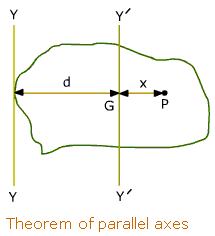Extension of Parallel Axis Theorem:
Assume an unsymmetrical area A illustrated in Figure, where CX and CY are the centroidal axes and KX1 and KY1 are axes parallel to centroidal axes through a point K along with co-ordinate (x1, y1).

This can be proved that product of inertia I x1 ,y1 with respect to axes KX1 and KY1 is always higher than I x,y about axes CX and CY and is computed as given under :
I x1 ,y 1 = I xy + A ( x1 y1 )
This equation is similar to parallel axes theorem for moment of inertia of an area & you may note down that the product of inertia is hence minimum w.r.t. centroidal axes for given directions X and Y.